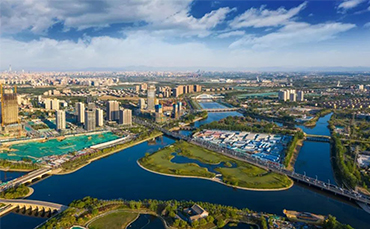



There is a beautiful picture with blue rivers, green plants and high-rise modern buildings at Tongzhou sub-center of Beijing where five rivers merge to be the north start point of the Grand Canal. Since the plan for Tongzhou sub-center was published in 2012, this city has changed every day and been different every month. Beijing Institute of Surveying and Mapping tracked the changes in the Grand Canal in Tongzhou from satellite photos. From these photos, we can see the memories of this city and find the big differences that happened in recent years.
The history of Yuanshui island and the five rivers
There is a place named the Five Confluences at Tongzhou Beiguan. Since the end of the Qing Dynasty, Wenyu River, Xiaozhong River confluenced with Tonghui River and then flew into the North Canal. After the founding of the People's Republic of China, in order to prevent flood, the Beiguan flood diversion hub project was built at the confluence of four rivers. In 1960, a flood blocking gate was built at the beginning of the North Canal. In the same year, a new channel named Yunchaojian River and a flood control gate were constructed started to be constructed and completed in 1963. Then, the Yunchaojian River can divert part of the flood water into the Chaobai River through the flood control gate. This new channel, as a man-made drainage channel connecting Wenyu River and Chaobai River, is the first mechanically constructed large-scale water conservancy project in Beijing.


The Five Confluences was formed in 2006 when Beijing began to dredge the five rivers. In the next year, the flood diversion hub of Beiguan was rebuilt and a new gate was built downstream. Then, Yuanshui Island with an area of 430 mu was formed between the new and old gates. In 2009, the Tonghui River and the Yunchao Reduced River were connected, and the five rivers merged at this place. Since then, a 750 mu small island has been formed at the confluence of the five rivers.
As the north start of the Grand Canal
At Five Confluences, there are three landmark buildings: Beiguan Gate-a stone arch bridge-shaped dam at the North Canal, Daguang Tower where household officials accepted grain during the Ming and Qing Dynasties, and the Buddha's burning lamp pagoda on the south bank of the Tonghui River. Together with the three landmark buildings, a stone showing the Beijing-Hangzhou Grand Canal north starting point stands on the shore on June 13, 2015, which is officially recognized as the north starting point of the Beijing-Hangzhou Grand Canal.

Since the Five Confluences was designated as the north starting point of the Grand Canal, Beijing has formulated three "three-year action plans" for sewage treatment and reclaimed water utilization. The North Canal management office has carried out a comprehensive water environment management of the North Canal basin.
In 2019, the Outline Plan for Protection, Inheritance and Utilization of the Grand Canal was issued, proposing building the Canal into a green ecological belt. In the same year, The State Council officially approved the Detailed Control Plan of Beijing City Sub-Center (Block Level) (2016-2035), which determined the urban spatial structure of "One Belt, One axis, and many points" of the sub-center. The Belt refers to the Grand Canal Ecological Belt, which aims to make the Grand Canal the framework to build urban green and blue networks. Along the Grand Canal, three main functional areas including the canal business district, sub-central comprehensive transportation hub and urban green center will be developed. In 2020, the Ministry of Ecology and Environment and other departments prepared the Special Plan for the Protection and Restoration of the Grand Canal's Ecological Environment, which aims to complete the construction of the ecological corridor of the Grand Canal by the end of the 14th Five-Year Plan.
Nowadays, the water quality of the North Canal has changed from the poor Ⅴ to Ⅳ and above. More than 30 kinds of birds and more than 10 kinds of aquatic plants have been observed in the Five Confluences area.
In April 2022, after 14 days of water replenishment, the Beijing-Hangzhou Grand Canal first got connected with water in a century. After the 40-kilometer northern river way of the Beijing-Hangzhou Grand Canal opened in 2021, Yangwa Lock was successfully constructed on June 26 this year, opening up the last break point of waterway transportation on the Beijing-Hebei section of the Grand Canal, and realizing inter-provincial navigation on the Beijing section of the Grand Canal and Xianghe section of Hebei Province simultaneously.
Photos from Beijing Institute of Surveying and Mapping
Source: <https://news.bjd.com.cn/2022/08/16/10134998.shtml>
Translated and edited by Mengyuan Jia